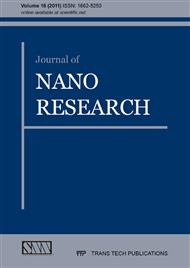[1]
X. Gaoa, S. Ching Tan, A.T.S. Wee, J. Wu, L. Kong, X. Yu, H.O. Moser, Structural and magnetic characterization of soft-magnetic FeCo alloy nanoparticles, Journal of Electron Spectroscopy and Related Phenomena 150 (2006) 11–14.
DOI: 10.1016/j.elspec.2005.07.004
Google Scholar
[2]
W. Laslouni, K. Taibi, D. Dahmoun, M. Azzaz, Structure and properties of nanocrystalline Cu70Fe18Co12 obtained by mechanical alloying, Journal of Non-Crystalline Solids 355 (2007) 2090-(2093).
DOI: 10.1016/j.jnoncrysol.2007.01.072
Google Scholar
[3]
R. Li, G. Liu, M. Stoica, J. Eckert, FeCo-based multiphase composites with high strength and large plastic deformation, Intermetallics 18 (2010) 134–139.
DOI: 10.1016/j.intermet.2009.07.003
Google Scholar
[4]
Z. Li, Y. Deng, B. Shen, W. Hu, Preparation and microwave absorption properties Ni-Fe3O4 hollow spheres, Materials Sciences Engineering B164 (2009) 112-115.
DOI: 10.1016/j.mseb.2009.08.004
Google Scholar
[5]
P. Poddar, J.L. Wilson, H. Srikanth, B.G. Ravi, J. Wachmuth, T.S. Sudarshan, Grain size influence on soft ferromagnetic properties in Fe-Co nanoparticles, Materials Science and Engineering B 106 (2004) 95-100.
DOI: 10.1016/j.mseb.2003.09.011
Google Scholar
[6]
S. Bergheul, H. Tafat, M. Azzaz, Formation and magnetic properties of nanocrystalline Fe60Co40 alloys produced by mechanical alloying, Journal of Materials Engineering and Performances 15 (2006) 349-335.
DOI: 10.1361/105994906x108675
Google Scholar
[7]
C. Suryanarayana, E. Ivanov, V.V. Boldyrec, The science and technology of mechanical alloying, Materials Science and Engineering A 304-306 (2001) 151-158.
DOI: 10.1016/s0921-5093(00)01465-9
Google Scholar
[8]
M. Delshad Chermahini, M. Zandrahimi, H. Shokrollahi, S. Sharafi, The effect of milling time and composition on microstructural and magnetic properties of nanostructured Fe–Co alloys, Journal of Alloys and Compounds 447 (2009) 45-50.
DOI: 10.1016/j.jallcom.2008.10.163
Google Scholar
[9]
X. Tang, Q. Tian, B. Zhao, K. Hu, The microwave electromagnetic and absorption properties of some porous iron powders, Materials Science and Engineering A 445-446 (2007) 135-140.
DOI: 10.1016/j.msea.2006.09.008
Google Scholar
[10]
W. Jang, Z. Hong, B. Shuxin, C. Ke, Z. Changrui, Microwave absorbing properties of rare-earth elements substituted W-type barium ferrite, Journal of Magnesium and Magnetic Materials 312 (2007) 310-313.
DOI: 10.1016/j.jmmm.2006.10.612
Google Scholar
[11]
L.Z. Wu, J. Ding, H.B. Jiang, L.F. Chen, C.K. Ong, Particle size influence to the microwave properties of iron based magnetic particulate composites, Journal of Magnetism and Magnetic Materials 285 (2005) 233-239.
DOI: 10.1016/j.jmmm.2004.07.045
Google Scholar


